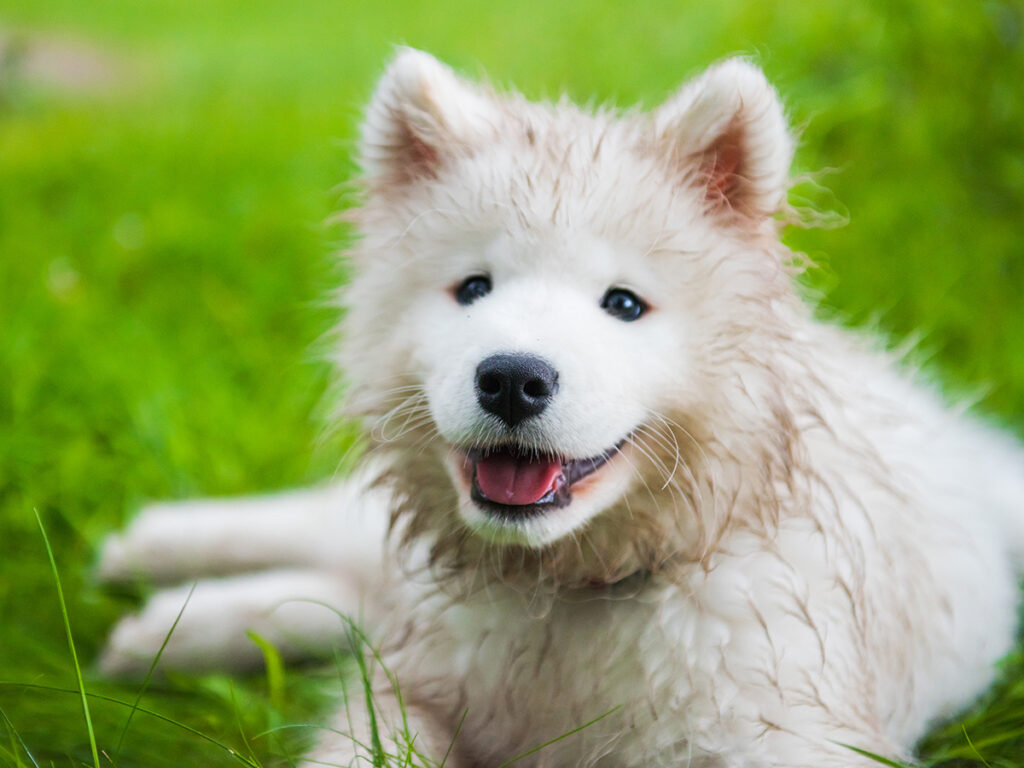We are guessing that you have made the exceptional choice of welcoming a Samoyed puppy into your home, or you are planning to. Congratulations!
These beautiful furry balls grow fast and get huge overnight! So naturally, one of the most common questions for most new Sammy parents is:
When does a Samoyed stop growing?
We’ve wondered the same thing when we were watching our Chuckie grow, and we had to find out the answer. Today, we will be sharing it with you, alongside a very useful growth and weight chart you can save to keep track of your pup’s progress!
Let’s take a look!
Table of Contents
How Long Does the Growing Phase Last?
Samoyeds are medium-sized dogs that belong to the group of working dogs. A Samoyed is usually considered immature until its second year of life. Of course, in some cases, the exact stage where they fully mature can vary even up to the third year.
At some point during this period, Samoyeds stop physically growing, depending on the particular dog.
It’s critical to pay attention to their health and development while they’re still puppies so that future health issues are minimized.
When Does a Samoyed Stop Growing?
Samoyeds reach their full size at 14-16 months old.
The exact period depends on whether it is a male or a female since females reach the final growth a little earlier.
After about half a year of their life, Samoyeds usually enter a significant growth spurt. The period between the sixth and twelfth month is where the differences between the boys and girls start to become more noticeable.
In the final stages of growth, Samoyeds gain an average height of 19-22 inches and a weight of 35 to 50 pounds (female) and 45-60 pounds (male).
Here is a handy resource that every Sammy parent should put on their fridge as their furry friend grows and develops:
Samoyed Growth & Weight Chart (Male & Female Puppies)
| Age | Avg. Male Weight (lbs) | Avg. Male Weight (kg) | Avg. Female Weight (lbs) | Avg. Female Weight (kg) |
|---|---|---|---|---|
| 1 month | 8 lbs | 3.5 kg | 8 lbs | 3.5 kg |
| 2 months | 12 lbs | 5.5 kg | 12 lbs | 5.5 kg |
| 3 months | 16 lbs | 7.5 kg | 15 lbs | 7.5 kg |
| 4 months | 25 lbs | 11 kg | 20 lbs | 9 kg |
| 5 months | 30 lbs | 13.5 kg | 25 lbs | 11 kg |
| 6 months | 35 lbs | 16 kg | 30 lbs | 13.5 kg |
| 7 months | 40 lbs | 18 kg | 32 lbs | 14.5 kg |
| 8 months | 42 lbs | 19 kg | 35 lbs | 16 kg |
| 9 months | 45 lbs | 20 kg | 35 lbs | 16 kg |
| 10 months | 50 lbs | 22.5 kg | 38 lbs | 17 kg |
| 11 months | 55 lbs | 25 kg | 38 lbs | 17 kg |
| 12 months | 60 lbs | 27 kg | 45 lbs | 20 kg |
| 14-16 months | 60 lbs | 27 kg | 45 lbs | 20 kg |
You can always refer to this chart whenever you start wondering if your Sammy is developing properly. For example:
How big should a 3-month-old Samoyed puppy be?
As you can see, both male and female Samoyed puppies should weigh around 12 lbs (55kg) at 3 months.
Keep in mind that these are average values based on data, and your puppy’s weight can vary. Still, if the difference is significant, please consult your vet.
More Reading: How Big Are Samoyeds? – The Average Size, Height & Weight
5 Tips To Follow During Growing Period
If you follow these tips and care for your dog properly, they will grow into a healthy, happy, smiling Sammy!


Tip #1 – Feed Your Puppy High-Quality Food
When puppies are growing rapidly, they need a lot of nutrients to keep up with their energy demands. Therefore, you should feed them with food containing all essential ingredients such as proteins, carbohydrates, and fats.
When choosing a food brand, remember to read carefully what’s included in its formula so that your pet gets everything they need from every meal!
Also, make sure to read up on our common diet questions:
Tip #2 – Keep Them Active
As a working breed, your Sammy needs a lot of exercise. Make sure your little ball of fur is active but don’t overwork them. Their bones are pretty sensitive during the growing phase. Here are a few ideas for activities:
- Take your pup on short walks multiple times throughout the day.
- Stimulate their brain with puppy puzzles and active play.
- Learn different commands.
Tip #3 – Don’t Overfeed Your Sammy
Overfeeding can lead to obesity which can cause significant health problems for dogs in adulthood, such as heart disease, arthritis, and diabetes, just to name a few!
To avoid that problem, be very cautious about how much food you give your puppy each day. No matter how cute their puppy eyes are, remember that it is your responsibility to keep their diet in check!
Tip #4 – Make Sure Your Samoyed Socializes
Make sure your buddy becomes familiar with other people and animals as soon as possible. It would be best to properly socialize your Samoyed early to prevent them from becoming overly stressed whenever they go on walks as adult dogs.
Socialization helps your Sammy get used to all sorts of different situations. They are naturally a very friendly breed, so you shouldn’t have much trouble with this.
Tip #5 – Check Your Puppy’s Weight Regularly
It would help if you regularly kept an eye on your puppy’s waistline. When they start putting on too much fat, it means that they are eating more than necessary, which can be risky for them in the future!
When this happens, cut down how many meals your dog gets per day and make sure to give them some type of exercise each time after their meal. This way, they will burn off those extra calories through movement instead of storing them as excess fat.
Conclusion
To sum up:
Most Samoyeds stop growing and reach maturity at 14-16 months. The exact timeframe depends on your dog’s gender, diet, genetics, and general health.
The five tips we have provided should help you take care of your pet to promote growth and avoid any health problems associated with overfeeding or lack of exercise.
See you in the next post!
